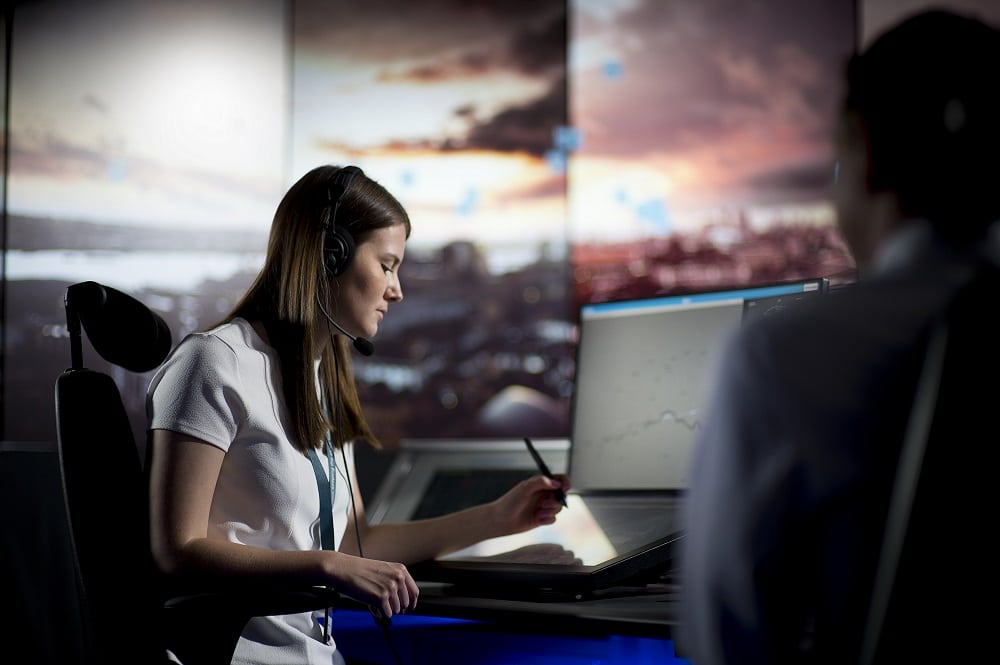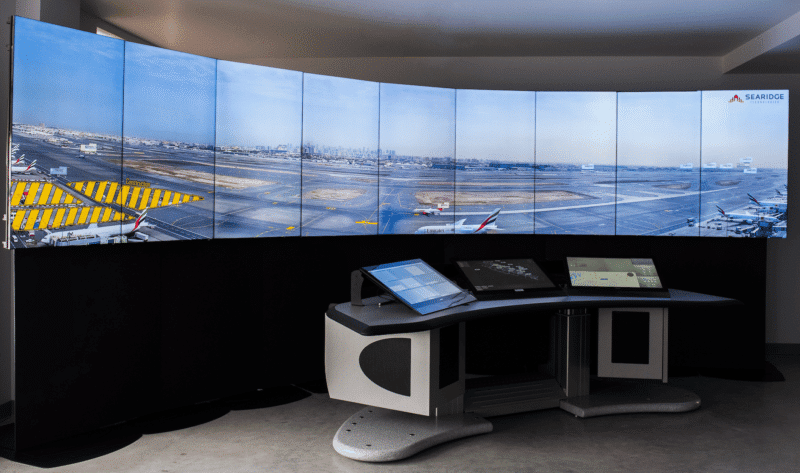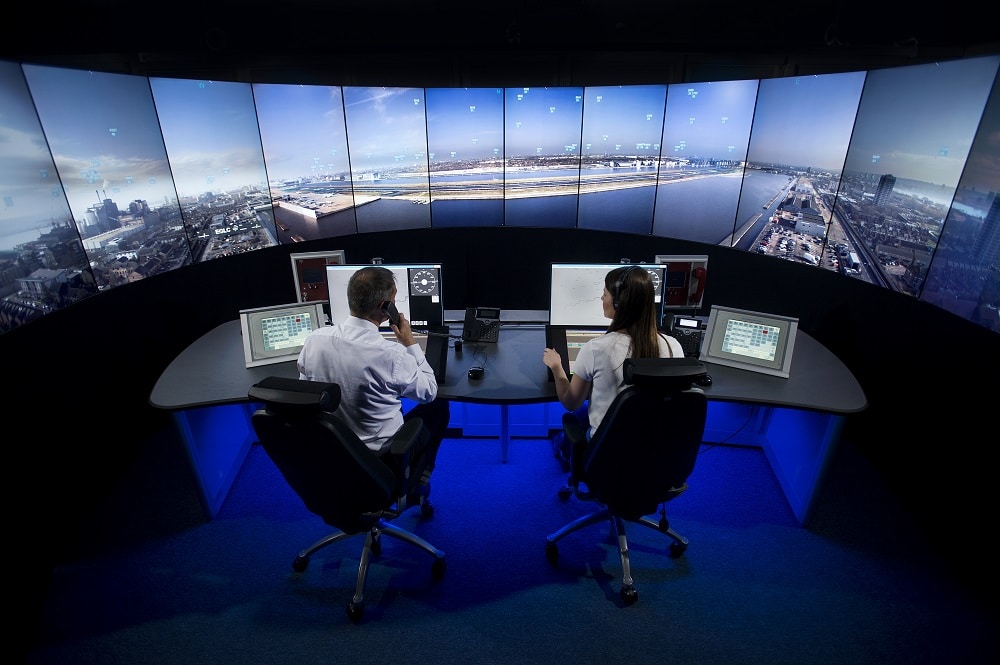Aviation
A London Airport Is Getting an Upgraded Air Traffic Control Tower-80 Miles Away From All the Planes

A London Airport Is Getting an Upgraded Air Traffic Control Tower-80 Miles Away From All the Planes
London’s City Airport is getting its high-tech upgrade in large part due to a lack of space. Instead of a bulky traditional tower that has to house actual humans, the new ATC tower will simply be host to a whole bunch of cameras, with live footage piped to controllers in a building some 18 miles away.
London’s City Airport is getting its high-tech upgrade in large part due to a lack of space. Instead of a bulky traditional tower that has to house actual humans, the new ATC tower will simply be host to a whole bunch of cameras, with live footage piped to controllers in a building some 18 miles away. There are additional benefits beside the saved space, too. The screens at the remote headquarters can compress a 360-degree view into 270 degrees, making it possible monitor more action in a smaller space
The airport is to decommission its traditional tower in 2019, meaning aircraft will be directed from a digital control room in Hampshire. Air traffic controllers will have a 360-degree, high definition view of the airfield, meaning they can monitor planes in more detail than by using the human eye, the airport said.
The technology has already been tested in Australia, Sweden, Norway and Ireland.
Current Situation –
The Tower Building Traditionally every airport has a conventional air traffic control tower, but they don’t come cheap. They cost millions to build and not all parts of the airfield are always visible. In comparison, going digital is more cost effective and offers real operational benefits.
A Digital Alternative
- Controllers use high definition cameras and remote sensing technology to safely and securely manage air traffic from a location away from the airport
- All operational data is transferred via a secure super-fast network to a custom built digital tower operations
room at NATS’ Swanwick air traffic control centre - Wrap around screens give the controllers an unparalleled view of the entire airport
The Technology
- High definition cameras provide a full 360 degree view of the airport
- Laser range finder for measuring distances to pin point accuracy
- Pan, tilt and zoom cameras to view any part of the airfield in unprecedented detail
- Displays enhanced with augmented reality style maps and aircraft data for increased controller awareness.
According NATS blogs Question and Answer.
How safe are digital control towers?
Everything is designed – from the technology to the procedures – with safety in mind and the same will apply for digital towers:
What happens if a camera fails?
In the system we’ll be using at London City Airport from 2019, there are 14 cameras, plus two separate ‘pan tilt zoom’ cameras. If one of the main cameras fails, one of the PTZs can quickly fill the gap until the camera can be swapped out and replaced.
What happens if all the cameras fail?
In the unlikely event that all the cameras fail, or that both of the independent video data feeds drop out, the team will revert to operating under Low Visibility Procedures as they do when in low cloud or fog, using voice communication and radar. This will slow things down, but it’s a normal part of ATC procedures and all very safe.
What about the screens?
There are 15 screens in the facility at Swanwick, meaning that if one of them fails the redundant one can instantly pick up the slack. The controllers can also rejig the order in which the screens display, meaning they will still see the airfield correctly. Then, at the right time, the defunct screen can be swapped out and replaced.
Can it be hacked?
Obviously we can never go into specifics about cyber security, but it is something we take incredibly seriously and keep under constant review. It is not an issue we ignore. What I can say it that the systems undergo extremely vigorous testing and for London City, we will have three entirely private and independent data feeds from the airport to Swanwick – two capable of carrying voice and video data, and the other just voice. 
Wouldn’t it be safer to be at the airport?
This is one I hear quite a lot and I always answer by turning the question around: could it not be safer and more resilient to have your ATC operation offsite? In any case the principle of controlling aircraft from a remote location isn’t new. Our radar controllers at Swanwick and Prestwick centres are looking after aircraft potentially hundreds of miles away and all without ever setting eyes on them.
Liked it ?
Share with your Friends and Family

Aviation
Boeing, Antonov to Collaborate on Defense Projects

– MOU represents Boeing’s commitment to work with Ukrainian industry
– Includes exploring opportunities for collaborating on in-country support of Unmanned Aerial Systems
A Memorandum of Understanding was signed today by Boeing and Antonov Company to investigate potential collaboration on defense-related projects.
“We’re happy to keep collaborating with the Antonov Company to help Ukraine’s economic development and expansion,” stated Ted Colbert, CEO and president of Boeing Defence, Space, & Security.
Airbus and the Antonov An-225: The Best Partnership:Click here
“This agreement demonstrates our ongoing efforts to find more opportunities to work with Ukrainian industry, which was underscored by our signing of the Ukrainian Defence Industry Compact earlier this year.”
The areas of potential collaboration identified in the agreement consist of training, logistical support and overhaul services for tactical Unmanned Aerial Systems utilized by the Ukrainian Armed Forces, which includes the ScanEagle. In addition, the companies will also explore opportunities for Antonov to provide engineering support to Boeing.
The six largest cargo aircraft ever built in the aviation industry:Click here
“A strong, innovative, and efficient defense industry is key to sustainable economic development and national security, and we are extremely excited to collaborate with Boeing,” said Ievhen Gavrylov, CEO of Antonov Company.
This agreement brings a whole new level of opportunity to implement the latest and most effective solutions – in addition to the possibility of future projects with Boeing in the aerospace and defense industry.”
-

 Travel1 week ago
Travel1 week agoAir India to Expand US Operations with Three New Routes After a Decade
-

 Travel2 weeks ago
Travel2 weeks agoWhy We Should Avoid These Stamps in a Passport
-

 Airlines1 month ago
Airlines1 month agoInvestigations Reveal Fake Chinese Titanium in Boeing and Airbus Jets
-

 Tech4 weeks ago
Tech4 weeks agoChina’s CATL Plans 1,800-Mile Electric Plane Launch by 2027
-

 Airport3 days ago
Airport3 days agoTop 10 Largest Airports in the World by Size
-

 Aerospace4 weeks ago
Aerospace4 weeks agoChina’s Fighter Jets Turn Wings into Autonomous Drones
-

 Airlines4 days ago
Airlines4 days agoAir India Rolls Out A350s for Delhi-New York JFK and Newark Routes
-

 Defence3 weeks ago
Defence3 weeks agoBoeing Enhances Chinook with New Engines and Block II Upgrades at $96 Million









